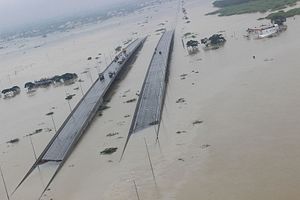India’s National Institute of Disaster Mitigation has identified floods as the most recurrent disaster in India and marked 23 Indian states as flood-prone. It further categorized urban floods and riverine floods, indicating that each requires different control strategies.
In December 2015, the city of Chennai in south India faced one of its worst natural disasters ever in the form of rain-induced urban floods that ravaged the city. At the precipice of the monsoon in the state of Tamil Nadu, of which Chennai is the capital, it is important to look at how flood mitigation and disaster preparedness efforts are shaping up in the city.
After the AIADMK government that was in power during the Chennai floods was re-elected this May, Chief Minister J. Jayalalithaa sanctioned $1.6 million toward putting flood-prevention machinery in place and desilting lakes and other water bodies. Earlier this month, Public Works Department Minister Edappadi K. Palaniswami instructed officials to complete mitigation efforts by the end of October in Chennai as well as in the neighboring districts of Cuddalore, Tiruvallur, and Kanchipuram in Tamil Nadu. District administrations and civic bodies in Chennai have met multiple times to ensure that systems are in place to pump out rainwater in the event of waterlogging. Palaniswami’s office has also reviewed the repair process of breaches in most of the water bodies that were worst hit last December.
The Chennai airport, which was among the worst-hit sites at the peak of the deluge, has been ramping up its preparedness efforts over the past ten days. A drone has been regularly surveying the airport to both look into mitigation and better understand how to divert water, which was a significant issue last year. Stormwater drains are being constructed in the parts of north Chennai that currently lack them and existing drains are being cleaned.
However, consternation among residents in the low-lying areas that faced maximum inundation is evident. Villages along the estuaries right around the city are equally frightened. The most common reason cited for this fear has been the pace of the implementation of flood-protection efforts.
In the areas surrounding Korattur lake, for instance, desilting began in February 2016 and has still not concluded. Residents and activists argue that the process is just too slow and have demanded the modification of culverts, emergency desilting, and an end to the periodic mixing of sewage and drinking water. Their arguments are laced with the memories of 20 days of pure inundation because of an improperly desilted excess water overflow canal. Repair work along the canal merging with the lakes nearby is still not complete either.
Even in the parts of north Chennai and the suburbs where drain systems are being revamped, the pace of widening roads has been slow. In the absence of wider roads, the entire process of revamping drains would be rendered useless – and already the height difference in particular concrete roads in the areas has raised the risk of water stagnation and mosquito breeding as the rains approach.
Right after the floods, as questions of repair, rehabilitation, and prevention emerged, the Chennai corporation indicated that 1,900 kilometers of clogged stormwater drains needed to be desilted. The mouths of rivers had to be cleaned of blockages and several thousand canals had to be cleared to have stronger storage capacities. The authorities themselves had expressed skepticism that all this work could be carried out in a few months’ time.
The reasons for this go deeper than just the December 2015 floods. Environmentalists, meteorologists, urban planners, and other analysts have, both prior to and particularly after the floods, provided detailed explanations of the inadequacy of the city’s drainage systems. They converge on the argument that Chennai is now horrifyingly flood prone due to breakneck urban expansion and the destruction of traditional drainage systems. Open spaces and flood plains with absorptive capacity are hubs of authorized and unauthorized construction.
A serious effort to look over flood maps of the city and reorganize dwellings in a manner that expands drainage is necessary. Planners in the city need to also bear such lessons in mind before proceeding with future projects. A huge amount of political capital is required to properly flood-proof the city and undo what reckless construction has brought about. It remains to be seen whether the government will mobilize this capital, but the past year has indicated that they are in no hurry to begin this process.
In the meanwhile, citizen groups like the Chennai Hub of the Global Shapers, a World Economic Forum initiative, have been organizing both citizen and expert discussions on lessons from the floods. They aim to evolve localized solutions to the problems and tap into proactive groups of individuals to mobilize the efforts required. For weeks last year, it was Chennai’s citizens that spearheaded relief efforts on the ground and through social media while contending with government delays. If the ten months that have elapsed since the floods are any indicator of how long-term flood mitigation plans are to unfold in the city, here too the government might take second place.

































